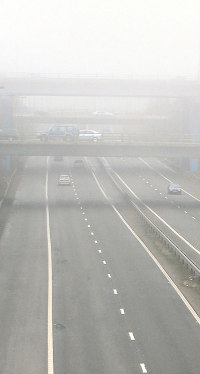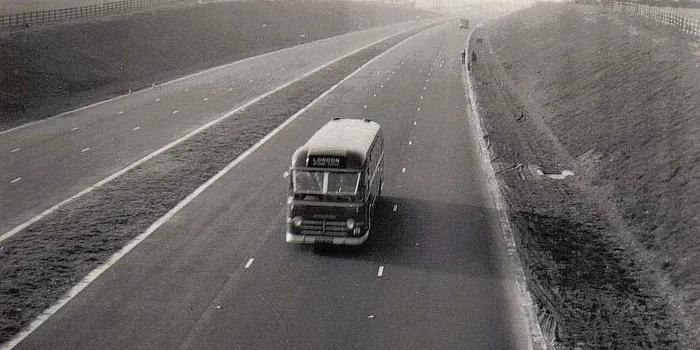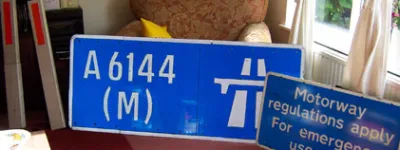As the road-building boom of the early 1960s progressed, hundreds of miles of new motorway came into service, and drivers everywhere had to learn how to use these new facilities. There was no speed limit and many motorists were old enough to have never taken a driving test, so accidents were bound to happen. But the worst accidents, and the greatest casualties and deaths, all happened in the fog. As the pile-ups continued to pile up, the press and public became restless about the dangers of a fog-bound motorway.
The reality was that many accidents and pile-ups were happening due to poor driving — people going too fast in the fog, mainly. There are reports of police cars trying to slow traffic down in thick fog and being repeatedly overtaken by faster traffic. But that did little to combat the feeling that the the authorities were responsible for making the road safe.
With regard to one particularly nasty incident on the M1 on 24 January 1964, which involved 200 vehicles, MPs called for "illuminated signs" to warn motorists of the fog. The Minister, Ernest Marples, began to sound increasingly exasperated as he replied:
"It is no good saying this fog was in belts. It was not in belts. It was forecast, it was expected, it was continuous, it was not patchy, it was widespread, it was not local. You do not need a sign to tell you there is fog when there is fog all around, any more than you need a sign to tell you it is raining when it is pouring with rain. Drivers must adjust speed techniques to prevailing weather conditions. If they are going to operate with folly, then folly will be the answer to them."

Marples was right that no amount of signs could save motorists from their own bad driving, and that a sign warning of fog was an absurdity when fog was all around. But fear of the dangers presented by the fast new motorways in winter conditions was continuing to grow, and just two days later another debate was granted in the Commons on the subject of "road safety". It was, in fact, another discussion on the same subject. Nothing much seemed to have been learned as MPs continued demanding the magic bullet: signs to warn drivers of fog.
Reginald Paget, the MP for Northampton, announced that he had actually driven in the fog on the M1 on the night of a particularly bad accident:
"During the recent fog I was travelling in the centre lane at about 40 miles an hour with an uncomfortable feeling that it was rather too fast. At one point an enormous lorry came past me doing at least 60 miles an hour in the fast lane. That impressed me enough to make me leave the road at the next turning.
"...I think it would be worth having neon lights on the bridges to show when there is 'Fog' or 'Ice'... I would tell the drivers of police cars to get into the fast lane and to travel down it at a speed which they considered to be safe."
Dudley Smith, MP for Brentford and Chiswick, responded with views that wouldn't sound out of place in a road safety debate today:
"In my view there are far too few police cars on traffic patrol...
"I put forward a personal plea on this, and I may not be supported by hon. Members, but I think that speed kills. I feel that on ordinary roads one should be restricted to a speed of 50 miles an hour, and on motorways to 70 miles an hour."
The start of the trial on the M5 was only a month away, a fact that Marples used to his advantage to close the debate. The truth was that a small-scale trial on one motorway would not be enough to make the public (and more importantly the press) feel safe on motorways in the fog. But with the roll-out of electronic signs nationwide still years away, what could be done?
Motorwarn
The general election in October 1964 brought a change of government and a new Minister of Transport, Tom Fraser. He arrived at the beginning of another winter that would see further accidents and pile-ups on the motorways, most notably in foggy conditions. By the time he'd been in post a year, and autumn was turning into winter again, he was running out of ways to head off the criticism facing his department.
The experimental system on the M5 was still not ready to be rolled out further, and even if it was, there was no funding for the installation of expensive signalling and control systems nationwide. Fraser found himself looking for something else that could be done quickly and cheaply. So it was that, in a series of meetings held between the 8th and 22nd November 1965, a plan was devised as an immediate response to what the Ministry of Transport called an emergency situation.
New signs for the brand-new 70mph speed limit on the M4 west of London, 1965
The plan had three parts:
- An experimental 70mph limit on all previously derestricted roads, including motorways;
- Improved arrangements for passing snow and fog warnings to the BBC for immediate broadcast; and
- An advisory 30mph speed limit on motorways, to be applied by the police in hazardous conditions, and indicated by the presence of flashing amber lights.

The imposition of the 70mph limit was, of course, the end of motoring in the UK without a speed limit, later being extended and then finally made permanent. That much is quite famous. The advisory 30mph limit is much more interesting because it required the Ministry to deploy a new signal, with flashing amber lights, to every mile of every motorway in England within the space of a month. The measures were announced on 24 November and the system was in operation — with new flashing lights and 70mph signs — from 22 December, a period of just 28 days.
The new signals were manufactured in road maintenance depots according to instructions circulated by the Ministry's central office in London, and were almost unbelievably makeshift. You could make your own, if you wanted, from materials available in any hardware shop.
Lucas, who manufacture vehicle lights, supplied 1,000 kits consisting of two orange fog lamps and an "electronic flasher unit". The lights were assembled on a wooden backing board, cut to size and painted black, and this in turn was mounted on a square-section wooden pole. Cables connected the lights to a padlocked metal box, painted yellow and stencilled with the letters "MOT", which contained a car battery, the electronics and a switch to operate the lights. The box was to be kept clear of the ground by placing it on some bricks. The whole underwhelming assembly was christened the "Motorwarn", but for advertising purposes the lights were nicknamed Yellow Perils.
"On motorways, when you see these ‘Yellow Perils' winking they are warning you that fog, snow, an accident or some other danger is ahead. The Police will never switch them on without a reason. So as soon as you see the ‘Yellow Perils' winking, slow down to 30mph or less. And be ready to slow down still further, or stop, when you know what the danger is."

The Motorwarn lamps were so temporary in nature that, when Tom Fraser went to the M4 near Heathrow to inaugurate the scheme in front of the press, he was embarrassed to find that a number of them had already been stolen. "I am not sure that I should say what I think of people who take warning lights", he told the press: "I should get into trouble with those who control the use of certain words in public places". Over the next few months the lightweight construction of the units, and the fact they contained a charged-up car battery, would prove too tempting for many passing motorists, and battery theft (though not usually theft of the entire signal) would become a recurrent irritation.
It's not clear how long Tom Fraser's Ministry thought these flimsy signals would last, but it soon became clear that they were going to have to stay until permanent signals could be installed — and nobody knew how long that would be.
On 16 December 1965, the Minister was confidentially briefed that there was no agreement or Treasury funding for a permanent signalling system and that nationwide rollout would have to be done over an extended period. He was told that "most, if not all, motorways will have to manage with the temporary flashing amber lights next winter also". In fact they would almost certainly have to manage much longer. Consideration was even given to providing a mains power supply to the lights as a stopgap measure in 1966. They were, eventually, equipped with sensors to allow them to be switched on and off using a radar gun, so that police could activate them without stopping the car.
Whether Motorwarn made a major contribution to road safety in the fog isn't all that clear, but it certainly removed some of the hysteria around foggy motorways and gave the Ministry of Transport some time to develop a real motorway signal. Their development work would result in a set of road signs that were, technologically, decades ahead of their time. Those signals would take another few years to hit the roads, and in the meantime, motorists would be faced with all manner of strange new signs.
Picture credits
- Photograph of Midland Red coach on the M1 by David Jones, from this photo gallery.
- Photograph of the M66 in the fog adapted from an original by David Dixon and used under this Creative Commons licence.

